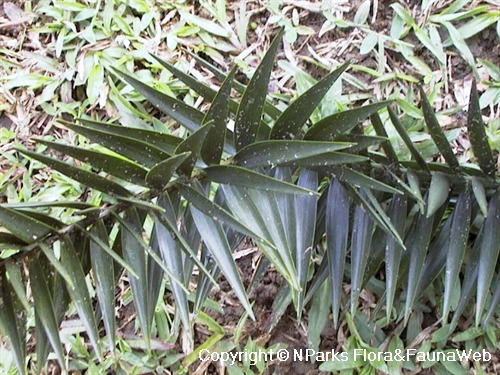.jpg)
Back
Araucaria columnaris (J.R.Forst.) Hook.
| Family Name: | Araucariaceae |
| Synonyms: | Araucaria cookii R.Br. ex Endl., Araucaria excelsa (Lamb.) R.Br., Araucaria intermedia R.Br. ex Vieill., Araucaria neocaledonica Linden ex Regel, Araucaria lavoixii Silba, Columbea excelsa (Lamb.) Spreng., Cupressus columnaris G.Forst., Dombeya excelsa Lamb., Eutacta cookii Carrière, Eutacta excelsa (Lamb.) Link, Eutacta humilis Carrière, Eutacta minor Carrière, Eutassa columnaris (G.Forst.) de Laub. |
| Common Name: | New Caledonia Pine, Cook Pine, Cook's Araucaria, 南洋彬 |
Name
Classifications and Characteristics
| Plant Division | Gymnosperms (Non-Flowering Seed Plants) (Conifer) |
|---|---|
| Plant Growth Form | Tree |
| Lifespan (in Singapore) | Perennial |
| Mode of Nutrition | Autotrophic |
| Plant Shape | Conical |
| Maximum Height | 25 m to 30 m |
Biogeography
| Native Distribution | New Caledonia |
|---|---|
| Preferred Climate Zone | Sub-Tropical / Monsoonal, Temperate |
Description and Ethnobotany
| Others - Plant Morphology | Tall evergreen conifer. Crown narrowly columnar, with branches set perpendicular and in whorls around trunk. Trunk has tendency to curve or lean, giving tree a dramatic silhouette. Bark dark brown, rough and papery, peeling off in thin strips. Leaves dark green, small and needle-like (0.5-1.0cm long), closely-overlapping and spiralling densely around twigs, giving branchlet an appearance of a plaited cord. Tree sheds whole branchlets rather than individual leaves. Cones produced at branch tips, male and female cones found on separate trees. Male cones cylindrical, pollen-bearing. Female cones (or seed cones) larger and broader, ovoid, woody with spiny cone scales, mature from green to brown, before disintegrating to disperse seeds. Seeds nutlike, triangular, with membranous wings. Cones and seeds seldom produced in Singapore. Fast-growing, drought-resistant tree suitable for parks, gardens or grown singly as specimen plant. Seldom grown along roadsides, as soot and dust tend to cover fine leaves. Named after Captain James Cook, who discovered plant on Isle of Pines in New Caledonia. |
|---|---|
| Ethnobotanical Uses | Food (Herb or Spice) Others: Young potted trees can be used as Christmas tree substitute in tropical regions. Also commonly planted as timber tree elsewhere for its lightweight softwood, decorative and straw-coloured, used to make furniture and bowls. Seeds are edible. |
Landscaping Features
| Desirable Plant Features | Ornamental Fruits |
|---|---|
| Landscape Uses | General, Coastal, Focal Plant |
Plant Care and Propagation
| Light Preference | Full Sun |
|---|---|
| Water Preference | Moderate Water |
| Plant Growth Rate | Moderate |
| Rootzone Tolerance | Saline Soils / Salt Spray, Disease / Pest Resistant, Drought Tolerant, Fertile Loamy Soils, Well-Drained Soils |
| Maintenance Requirements | Low |
| Propagation Method | Seed |
Foliar
| Foliage Retention | Evergreen |
|---|---|
| Mature Foliage Colour(s) | Green |
| Mature Foliage Texture(s) | Thick |
| Foliar Modification | Reduced / Needle-like |
| Foliar Type | Simple / Unifoliate |
| Foliar Arrangement Along Stem | Spiral |
| Foliar Shape(s) | Non-Palm Foliage (Linear) |
| Foliar Margin | Entire |
| Typical Foliar Area | Nanophyll ( 0.25cm2 - 2.25 cm2 ) |
| Leaf Area Index (LAI) for Green Plot Ratio | 2.5 (Tree - Open Canopy) |
Non - Foliar and Storage
| Trunk Type (Non Palm) | Woody |
|---|---|
| Bark Colour(s) | Greyish brown |
| Mature Bark Texture | Peeling / Flaking / Papery |
| Stem Type & Modification | Woody |
| Root Type | Underground (Tap Root, Fibrous Root) |
| Mature Bark Texture Remarks | Rough, papery bark that peels off in thin strips |
Floral (Angiosperm)
| Flower & Plant Sexuality | Unisexual Flowers , Dioecious |
Fruit, Seed and Spore
| Mature Fruit Colour(s) | Brown |
|---|---|
| Fruit Classification | Simple Fruit |
| Fruit Type | Indehiscent Dry Fruit |
Image Repository
Others
| Master ID | 1428 |
|---|---|
| Species ID | 2721 |
| Flora Disclaimer | The information in this website has been compiled from reliable sources, such as reference works on medicinal plants. It is not a substitute for medical advice or treatment and NParks does not purport to provide any medical advice. Readers should always consult his/her physician before using or consuming a plant for medicinal purposes. |

.jpg)
.jpg)
.jpg)
.jpg)
.jpg)


_lowres.jpg)
